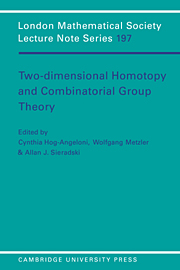Book contents
- Frontmatter
- Contents
- Editors' Preface
- Addresses of Authors
- I Geometric Aspects of Two-Dimensional Complexes
- II Algebraic Topology for Two Dimensional Complexes
- III Homotopy and Homology Classification of 2-Complexes
- IV Crossed Modules and Π2 Homotopy Modules
- V Calculating Generators of Π2
- VI Applications of Diagrams to Decision Problems
- VII Fox Ideals, N-Torsion and Applications to Groups and 3-Manifolds
- VIII (Singular) 3-Manifolds
- IX Cancellation Results for 2-Complexes and 4-Manifolds and Some Applications
- X J. H. C. Whitehead's Asphericity Question
- XI Zeeman's Collapsing Conjecture
- XII The Andrews-Curtis Conjecture and its Generalizations
- Bibliography
- Index
IX - Cancellation Results for 2-Complexes and 4-Manifolds and Some Applications
Published online by Cambridge University Press: 20 January 2010
- Frontmatter
- Contents
- Editors' Preface
- Addresses of Authors
- I Geometric Aspects of Two-Dimensional Complexes
- II Algebraic Topology for Two Dimensional Complexes
- III Homotopy and Homology Classification of 2-Complexes
- IV Crossed Modules and Π2 Homotopy Modules
- V Calculating Generators of Π2
- VI Applications of Diagrams to Decision Problems
- VII Fox Ideals, N-Torsion and Applications to Groups and 3-Manifolds
- VIII (Singular) 3-Manifolds
- IX Cancellation Results for 2-Complexes and 4-Manifolds and Some Applications
- X J. H. C. Whitehead's Asphericity Question
- XI Zeeman's Collapsing Conjecture
- XII The Andrews-Curtis Conjecture and its Generalizations
- Bibliography
- Index
Summary
This is a survey chapter. The idea is to summarize some recent work which illustrates in one way or another the connection between topology in dimension 2 and the study of 4-dimensional manifolds. There are almost no new results and no result is proved completely in the paper. Instead, in each section we collect together some related statements and motivation, and give a sketch of some typical or important steps in the proofs.
A Cancellation Theorem for 2-Complexes
Any two finite 2-complexes K, K′ with isomorphic fundamental groups become simple homotopy equivalent after wedging with a sufficiently large (finite) number of S2's (see chapter I, (40)). Furthermore, if α : π1(K, x0) → π1(K′, x′ 0) is a given isomorphism and K, K′ have the same Euler characteristic, then there is a simple-homotopy equivalence f : K ∨ rS2 → K′ ∨ rS2 inducing α on the fundamental groups. For a given group π, the minimal number r with the property above for all finite 2-complexes with this fundamental group is called the stable range.
It is known that for finite fundamental groups the stable range is always ≤ 2 ([Dy81], Theorem 3). The main result of this section is the following.
Theorem 1.1 ([HaKr921]) Let K and K′ be finite 2-complexes with the same Euler characteristic and finite fundamental group. Let α : π1 (K, x0) → π1(K′, x′0) be a given isomorphism and suppose that K ≃ K0 ∨ S2. Then there is a simple-homotopy equivalence f : K → K′ inducing α on the fundamental groups.
- Type
- Chapter
- Information
- Two-Dimensional Homotopy and Combinatorial Group Theory , pp. 281 - 308Publisher: Cambridge University PressPrint publication year: 1993
- 2
- Cited by



